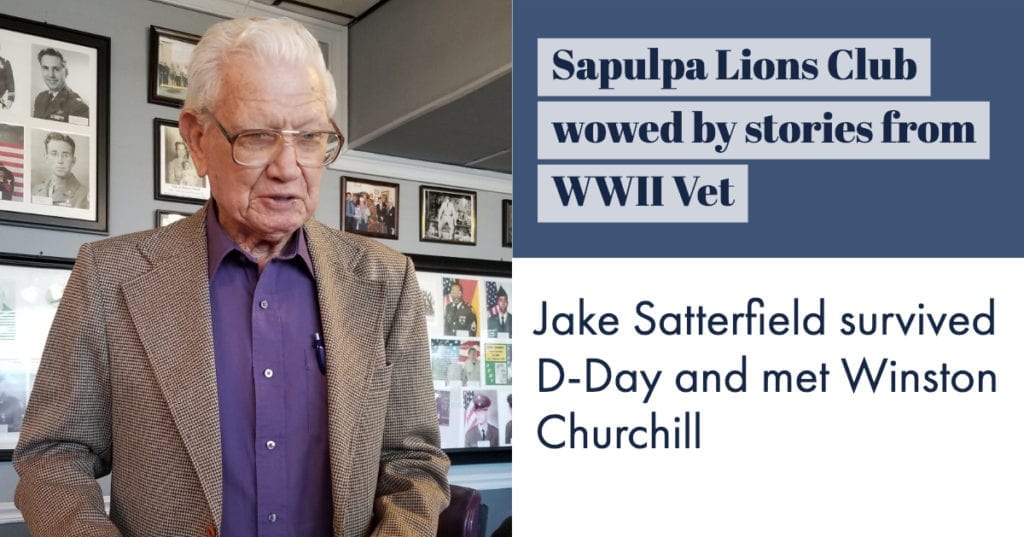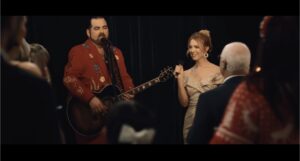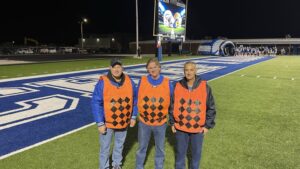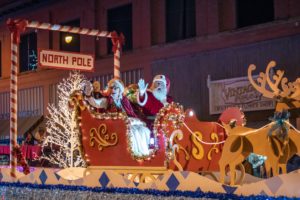The Sapulpa Lions hosted a World War II veteran, Jake Satterfield, and packed the Veteran’s Room at the Steak & Eggs Restaurant on Wednesday at noon. The “Lion of the Day,” John Mark Young, brought the guest speaker to the Lions, after having read a Tulsa World article about him, and then found out Satterfield lived in Sapulpa.
John Mark Young, a retired Marine officer, jokingly apologized to everyone for inviting a “U. S. Navy sailor.” To which the guest of honor, ninety-four-year-old Satterfield quipped, “Hey, I was a ‘Seabee’.”
As part of his introduction, Young said, “He shook hands with Winston Churchill… They’re not making anymore like him.” Young mentioned Satterfield’s wife, Dorotha, and his adopted daughter, Terri Wadly. Again, Satterfield joked, “We adopted her at 6 months old—nothing but trouble!”
Jake Satterfield began his speech saying, “I couldn’t discuss nothing about where I’d been. It was horrible! Couldn’t even talk to my family.” He said it had helped him to talk about it.
He was born in 1924 in Mountainburg, Arkansas. His mother refused to sign papers for him to join the service before he graduated high school. He had polio for 2 years as a child, and was worried they wouldn’t take him. “Germany was taking over countries,” and he wanted to go.
First thing he did after boot camp and Construction Battalion (CB) training, was to go to Glasgow, Scotland, and later Plymouth, England, to build quonset huts. “It (the ship he went over on) was the ‘Empress of Australia.’ It was built by Kaiser Wilhelm to cruise the world during World War I. It was beautiful, stairways…not too sure how it looked after a bunch of U. S. soldiers got through with it.”
The quonset huts were built as R&R sites for service members to be able to get out of the fray for awhile. His team worked long shifts, wading in knee-deep mud to accomplish these projects.
At South Hampton, the CBs completely repaired and painted a big hospital. “We were busy boys.”
In London, his “boys” rode enormous concrete blocks down the Thames River, pulled by tugboats. These concrete and steel bridge spans were 60ft wide, 200ft tall, and 300ft long. They were building an artificial harbor to get ready for the invasion, and unloaded tanks and other equipment on it. They were slowed down by a monster storm and the troops were working 12-hour shifts, 4pm to 4am, all the while being buzz-bombed. It was called “Buzz Bomb Alley.”
“It was foggy, never saw one, I could hear it…Had just enough fuel to get to London, and ran out of fuel.
D-Day
Next, Satterfield spoke about Omaha Beach. The big cliff next to it was where the German soldiers were hiding and firing from. A battleship was grounded nearby and fired 2 shots into the cliff. “The Germans didn’t shoot us anymore.”
“We were at the mercy of the tugboats,” he said. Then he mused about a lot of young men lost, but the mission was “pretty successful.”
One D-Day story: “There was a 19-year-old kid from Arkansas who had to pick up bodies for 2 weeks. He would carry one body, throw-up, go get another body, and repeat. I thought about all those young men handling those bodies, and nothing you could do about it.”
Another one: Elmo Tanner, an attorney from Claremore, was a buddy and we shared tent. We were laying there, we could hear the guns. The stick pole that holds the center of the tent broke. It came down and hit us in the face. Sounded like a gun. We come running out of there, pouring down rain, and dark. We was scared old boys.”
Winston Churchill and the Prime Ministers of Australia and New Zealand came to visit the troops. “It was a very good visit. He talked to each one of us. He was not show-off, but real calm.” Churchill was down to earth with the boys, he said.
In Guam
“I went back to the States and wound up in Guam. The Seabees on Guam were taking care of spare tires, all sizes from bicycle-tire-high, any size…just big.”
He operated a crane. “I had back trouble once in awhile and the guys had to pick me up and get (me) up in that crane.” He spent one year operating the crane. He didn’t tell anyone he was hurt because he didn’t want to get shipped-out to sick bay or back home.
Then, they sent them headed to the West Coast, but when they arrived at Pearl Harbor, they found out there was no room for them in California so they headed to Norfolk, Virginia. The war had ended by then.
He spent 30 days on a troop ship, and wanted to get home from Guam to the Panama Canal and ended up in New York. From there, he went to Memphis to be discharged. “You talk about some disgusted bunch of guys, within 2-3 days of going home.”
He was invited to Bishop Kelly to speak to the kids, but he wasn’t sure he could talk about it. He got through it.
“I hope you never, never have to go through things like that. Mine was short and I didn’t go through want a lot of guys went through. Horrible, horrible. Most horrible things that can happen that a 19-year-old kid from Arkansas. “
Did you go back?
“Yes, but not the parts I was in.”
Did you go back to New York?
“No, I sure would like to have stayed there then, but not now. I went to work for Frisco railroad, installing signals.”
It’s a sad reality that men like Satterfield are becoming fewer all the time, and with them, we’re losing the stories like those he told on Wednesday. How can we encourage those we have left to share their stories?
“My best advice is “Don’t push anyone to talk about it (their war experience).”
Lottie Wilds contributed to this story.











